
Living or visiting Connecticut and wondering what bird you’re looking at? This article covers the most common birds of Connecticut. Odds are high the bird you’re looking at is one of them. It will also inform you on how to identify them.
Connecticut is a wonderful state for birding, especially for the multitude of shorebirds on Long Island Sound and the coastline. Birders should consider that the shore becomes crowded during the summer, making spring and fall a better bird-sighting option. Although Connecticut is the third smallest state in the U.S., it has 430 species of birds.
Litchfield’s White Memorial Conservation Center has 4,000 acres of birding habitats that include forests, marshlands, and river edges. Birders can explore the 40 miles of trails or canoe down the Bantam River for sightings. They will find, among other species, Broad-wing Hawk, Willow Flycatcher, Yellow-throated Vireo, Scarlet Tanager, and the Pileated Woodpecker.
Bantam Lake is a haven for waterfowls, including the migrating Least Bittern, American Bittern, and Common Gallinule. Osprey and the Bald Eagle are a non-infrequent sight.
The Audubon Center in Greenwich is in a 285-acre sanctuary with seven miles of birding trails. The trails wind through deciduous forests, swamps, a river, and a lake. Birders are likely to spot a Ruffed Grouse, Great Crested Flycatcher, Tree Swallow, Ovenbird, several Warblers, and the beautiful Baltimore Oriole. Birders can contact the Center regarding their fall hawk watch – over 20,000 raptors have been spotted during certain years.
Sherwood Island State Park is a large coastal park with woodland and beaches, a great place to see waterfowls such as the Glossy IBIS, Long-tailed Duck, and the Least Bittern in the spring.
Milford Point, close to the town of Milford, has been officially named an “Important Bird Area” for its abundance of shorebirds and waterfowl. The Point conveniently has an observation platform and a tower.
Lighthouse Point Park near New Haven has 15,000 raptors migrating from September to November, making this the most famous hawk watch in New England. Some of the raptors are the Turkey Vulture, Red-shouldered Hawk, and the Peregrine Falcon, among many others, possibly even a Golden Eagle. The park itself has several programs about bird migration.
Common Birds of Connecticut
Red-winged Blackbird
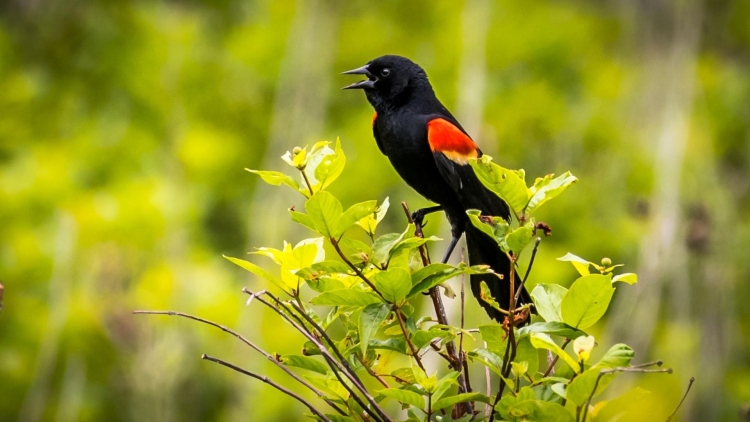
The marvelous Red-winged Blackbird is glossy black with elegant red and yellow markings on the wings. Females can be more brown than black. They grow between 6.7 to 9.1 inches and weigh 1.1 to 2.7 ounces with a wingspan of 12.2 to 15.8 inches. The males live to get noticed as they sit perched high all day and sing. Females are busy searching for worms, insects, seeds, and berries.
They live near marshes and watercourses during the summer and can be found in fields and pastures during the winter. They are in Connecticut all year.
Gray Catbird
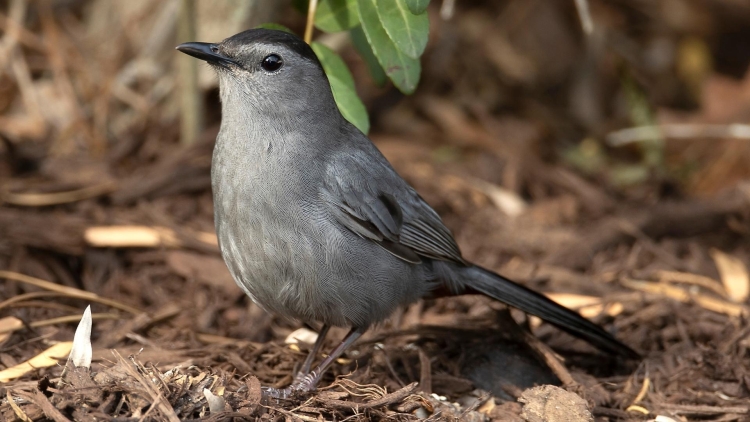
The Gray Catbird is a slender slate-gray bird with a long tail, long legs, and a black cap on the top of its head. The male and the female look alike, and it is easy to confuse them. They grow 8.3 to 9.4 inches in length, and weigh between 0.8 and 2.0 ounces with a wingspan of 8.7 to 11.8 inches. They can be seen in Connecticut between May and October.
They do not inhabit forests. Instead, they live on farmland and scrublands, where they feed on worms, insects, and fruits.
Northern Mockingbird
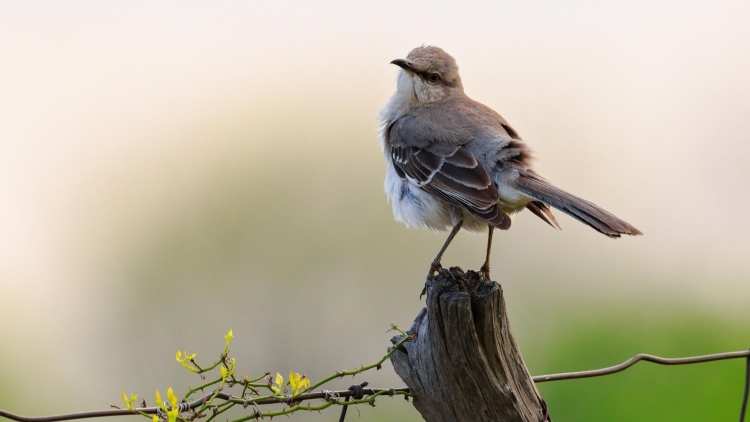
The Northern Mockingbird is a slender gray bird with white underparts and two white bars on its wings, a long tail, and a dark line by the eye. They grow from 8.1 to 11.0 inches and weigh 1.4 to 2.0 ounces with a wingspan of 12 to 15 inches. They like tall trees in parks and gardens and will feed off spiders, insects, and berries.
Brown Thrasher
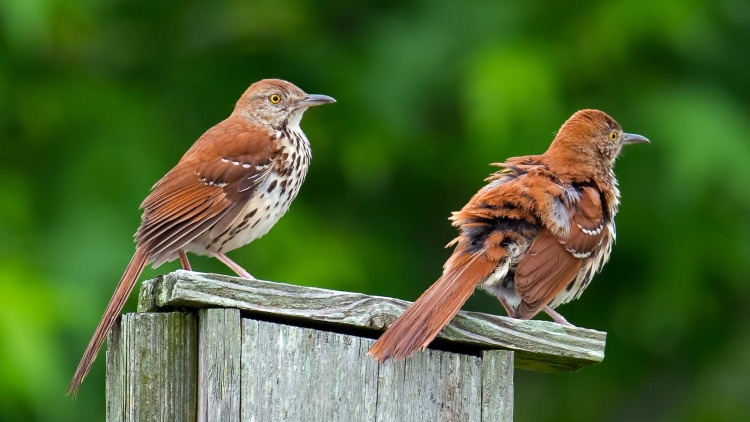
The Brown Trasher likes to remain hidden in shrubby areas. In Connecticut, they can be found by Mondo Ponds, East Rock Park, Bantam Lake, and the Barn Island Wildlife Management.
Brown Thrashers are long birds with long legs, a long tail, and two black and white bars on their wings. They are a rusty-brown color with dark streaks on the underbelly. The face is a gray-brown with yellow eyes. They grow to 9.1 and 11.8 inches and weigh 2.1 and 3.1 ounces with a wingspan between 11.4 and 12.6.
They like shrubby undergrowth for cover and will sing from treetops. Brown Trashers feed on insects, berries, and seeds.
Wood Thrush
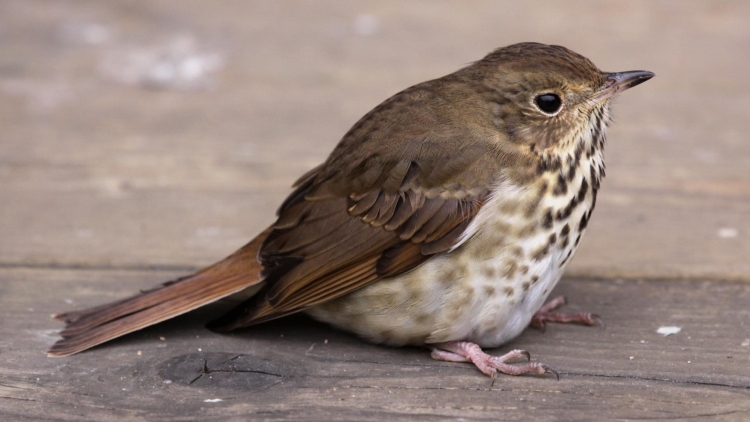
The Wood Thrush inhabits the forests of rural Connecticut, preferably deciduous forests with shrubs. They search for food on dirt roads, such as the roads through Natchaug State Forest and Pomfret’s Needle’s Eye Road. They can most easily be seen from May to August feeding on insects, seeds, worms, nuts, and berries.
The Wood Thrush has a reddish brown back, wings, head, thick bill, and tail, and white breast and underbelly with dark markings.
They grow from 18 to 21.5 inches in length and weigh 1.7 to 2.5 ounces with a wingspan between 12 to 16 inches.
Common Birds of Connecticut by Color
Black Birds in Connecticut
Brewer’s Blackbird
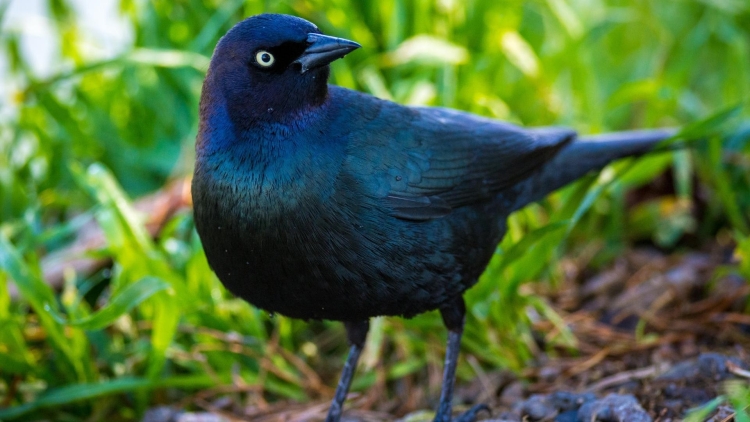
The Brewer’s Blackbird is a long-legged bird with a round head and a long beak. They grow to 8.3 to 9.8 inches in length, and weigh 2.1 to 3.0 ounces, with a wingspan of 14.6 inches. The males are entirely glossy black with a blue tint to the head and yellow eyes. The females lean toward a brownish hue.
They inhabit grassland, areas near water, as well as parks and golf courses and feed on insects, seeds, fruits, and grains that they forage from the ground.
Chestnut-collared Longspur
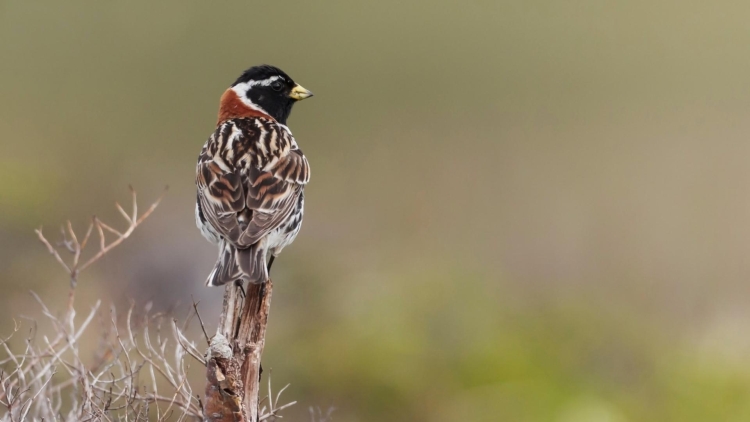
The Chestnut-collared Longspur grows 5.1 to 6.5 inches in length and weighs 0.6 to 0.8 ounces. Males have a black chest and belly with a pale, creamy face and throat and a black stripe by the eye. Its outstanding characteristic is the chestnut-colored nape. Females are a more subdued gray with streaks across the breast and smudgy cheeks. The tail is white with a black mark in the center.
They are prairie birds that inhabit grassland and feed mostly on seeds, as well as insects and spiders.
Lark Bunting
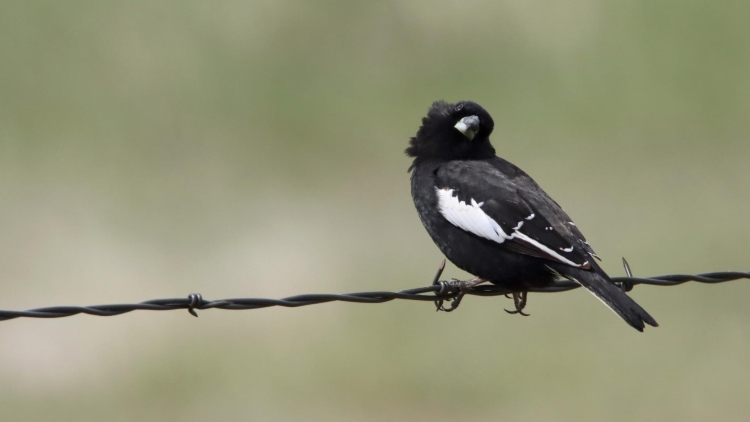
The breeding Lark Bunting male is a stylish black with white patches on the wings. Regular males and females are brown on top with brown streaking below and white underwings. Their bill is blue-gray. They grow 5.5 to 7.1 inches and weigh 1.3 to 1.5 ounces with a wingspan of 9.8 to 11.0 inches.
They inhabit open grassland and fields and forage the ground for insects.
Blue Birds in Connecticut
Lazuli Bunting
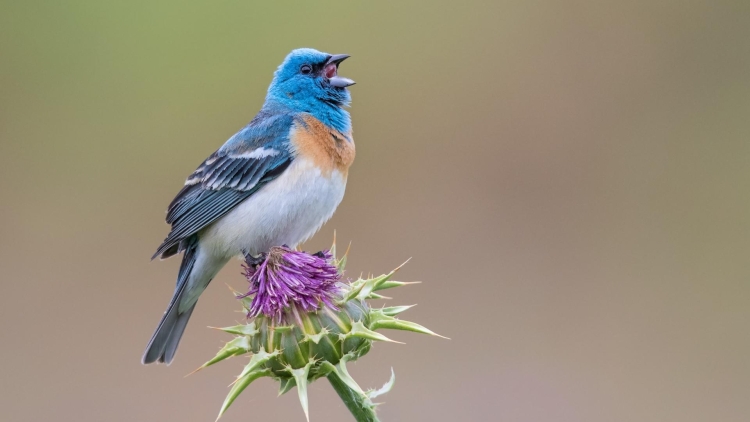
The Lazuli Bunting grows 5.1 to 5.9 in length and weighs 0.5 to 0.6 ounces with a wingspan of 8.7 inches. The male has a vivid blue head and back with white wing bars and a tawny breast and white belly. The lovely blue shade turns browner during the winter months. The female is a dull brown with a pale underbelly.
Eastern Bluebird

The Eastern Bluebird is a small round bird with a big head and eyes and long wings. The legs, bill, and tail are short by comparison. They grow 6.3 to 8.3 inches and weigh 1.0 to 1.1 ounces with a wingspan between 9.8 to 12.6 inches. The male is a deep blue with a red throat and breast. The female is grayer above with a rusty breast.
They live in open areas such as golf courses and meadows with enough trees that have nest cavities and feed on insects and berries.
Mountain Bluebird
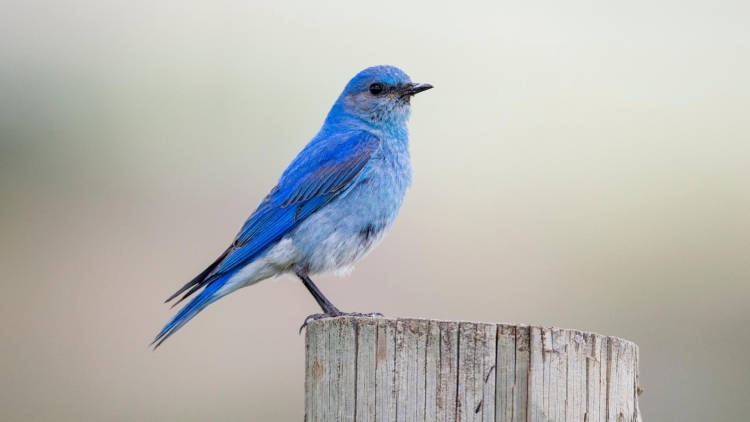
Discovering a Mountain Bluebird in Connecticut is a birder’s delight. They can be spotted specifically near Bradley International Airport on Perimeter Road. They are small with a round head and a thin bill and a long tail. They grow 6.3 to 7.9 inches in length and weigh 1.1 ounces with a wingspan between 11.0 to 14.2. The male is a bright blue with darker wings and a pale blue belly. Some have a rusty-orange chest. The female is a tawny brown with a few blue spots on the wings.
They can be spotted in open spaces, such as grassland, where they feed on insects and berries.
Red Birds in Connecticut
An interesting point regarding red birds is that the color invariably refers to the male. The “red” female usually leans toward the dull in comparison.
Northern Cardinal

The Northern Cardinal inhabits Connecticut all year round. If there were an avian beauty contest, there is no doubt the male Northern Cardinal would advance effortlessly to the evening gown portion of the program. The male is an all-over bright red with a mysterious mask around the eyes and throat, a red beak, a jaunty red crest on the top of his head, and a long tail. The female is paler, more orange, with some red in the wings and tails.
They have a very recognizable sound, and, unusual for birds, even the female joins in. The Northern Cardinal grows 8.3 to 9.1 inches in length and weighs between 1.5 and 1.7 ounces with a wingspan between 9.8 and 12.2 inches.
They inhabit shrubby forests, backyards, and parks, where they feed on insects, sunflower seeds, flies, and fruits such as blackberry, mulberry, and wild grape.
Scarlet Tanager
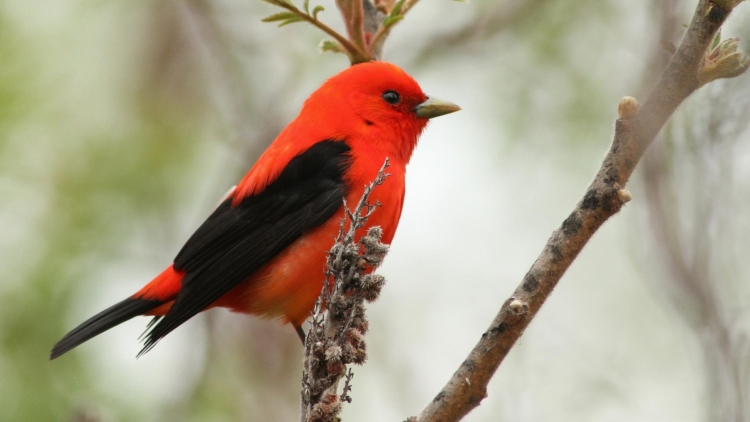
The Scarlet Tanager is a stocky bird with a thick bill that can be found in deciduous and conifer forests of Connecticut. Birders can argue forever which red bird is the most stunning – the Northern Cardinal or the Scarlet Tanager. The male is beyond dazzling, with its fire-engine red body and perfect glossy black wings and tail. The tawny, dark-winged female fades into the scenery. They grow 6.3 to 6.7 inches in length and weigh 0.8 and 1.3 ounces with a wingspan between 9.8 and 11.4 inches.
They feed primarily on insects during the summer and eat more fruit during the winter. They nest high up in the canopy and can be difficult to spot.
Purple Finch

Purple Finch grow 4.7 to 6.3 inches in length and weigh 0.6 to 1.1 ounces with a wingspan between 8.7 and 10.2 inches. The male is pinkish-red on the head and breast, with some brown mixed into the back. The belly is a light, blush pink. The female is not red at all. Instead, she is a streaked brown and white. Both male and female have a thick, cone-shaped bill.
The Purple Finch can be spotted year-round at the Connecticut Audubon’s Center in Fairfield and in Earle Park at Glastonbury. They will visit bird feeders for black sunflower seeds.
Orange Birds in Connecticut
Barn Swallow
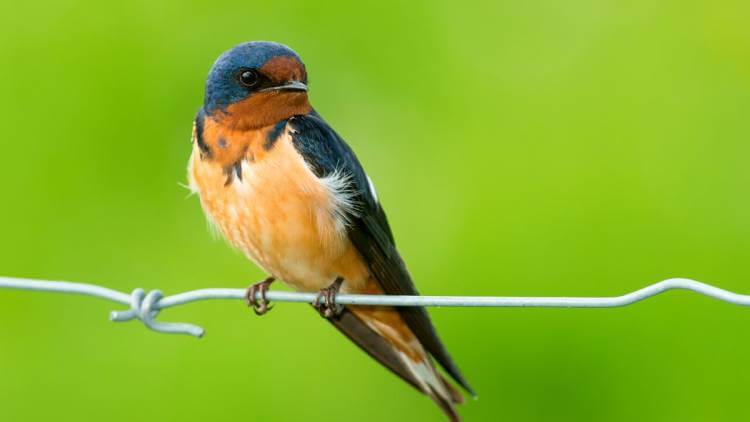
The Barn Swallow has a flattened head, no neck, long wings, and a long, forked tail. The back and face are blue, while the forehead and throat are a rusty-orange color. The female coloring is less bright. The Barn Swallow grows between 5.9 to 7.5 inches and weighs 0.6 to 0.7 ounces with a wingspan between 11.4 and 12.6 inches. They inhabit open fields, meadows, parks, and coastal areas. Their diet consists mostly of insects, and they only rarely forage for seeds or berries.
In Connecticut, Goose Island in the Connecticut River has become a Barn Swallow gathering site, with as many as 500,000 hovering and landing within the reeds.
Red-breasted Nuthatch

The Red-breasted Nuthatch is a plump bird with no neck and short but broad wings. Red-breasted Nuthatch is blue-gray with a black cap and a distinctive black stripe through the eye. The underparts are a rich orange-cinnamon in the male and a lighter color in the female. They grow to 4.3 inches and weigh 0.3 to 0.5 ounces with a wingspan between 7.1 and 7.9 inches.
They inhabit coniferous forests and nest in spruce and pine trees. One of the best places to spot the Red-breasted Nuthatch is the White Memorial in Litchfield County during the summer. Their diet consists of insects and spiders, and they add conifer seeds during the winter.
American Redstart
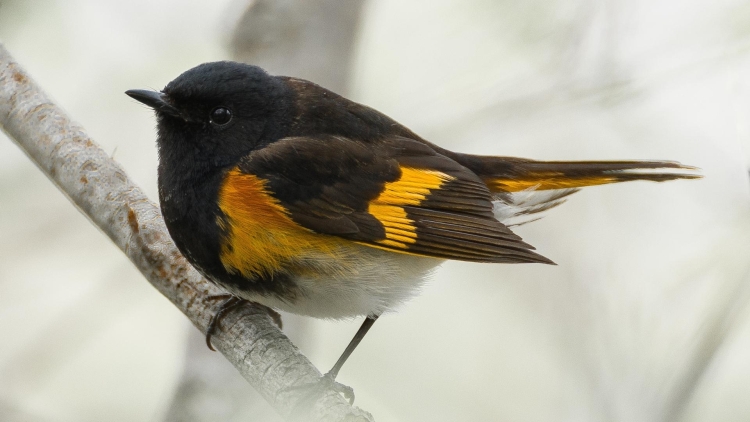
The American Redstart is a medium-sized bird with a long tail. The male is black with a few white stripes and an orange and white underbelly and orange spots on the tail. The female is yellowish with grey underparts. They grow 4.3 to 5.1 inches in length and weigh 0.2 to 0.3 ounces with a wingspan of 6.3 to 7.5 inches.
They inhabit deciduous forests and use their tail to scare insects, which they snap up.
Yellow Birds in Connecticut
Common Yellowthroat
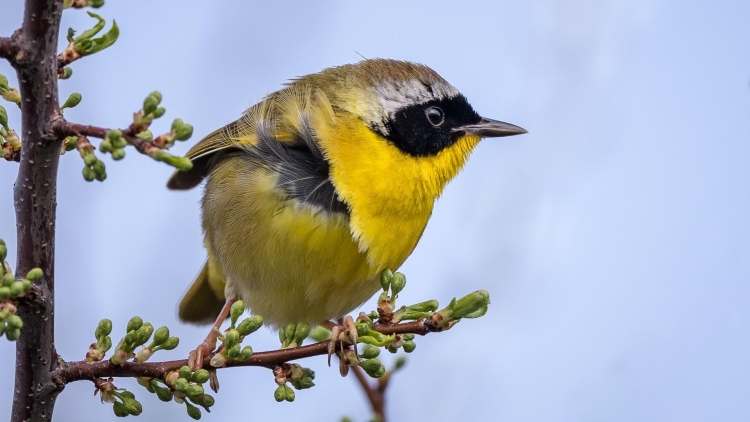
The Common Yellowthroat spends May to October in Connecticut to breed. They are brown in the back, and both the male and female have a vibrant yellow underbelly and a long tail. The male has a black mask across the eyes with a white line above it. They grow 4.3 to 5.1 inches in length, weigh 0.3 ounces, and have a wingspan between 5.9 and 7.5 inches.
They inhabit wetlands, forest edges, and fields and hide in dense undergrowth looking for insects and spiders.
Cedar Waxwing

The Cedar Waxwing is difficult to track down in Connecticut. It can frequently be found feeding on the berries of the Eastern Red Cedar during winter and spring. They are a shiny pinkish gray with a black mask and a crest that gives them a very grumpy look. The tip of their tail is a shiny bright yellow, and the underbelly is a paler yellow. They grow 5.5 to 6.7 in length, with 1.1 ounces with a wingspan of 8.7 to 11.8.
They inhabit woodland, wetlands, and fields. What they look for is trees with fruit, although they will snap up the occasional insect. Mostly, however, they are eager fruit eaters.
Yellow Warbler
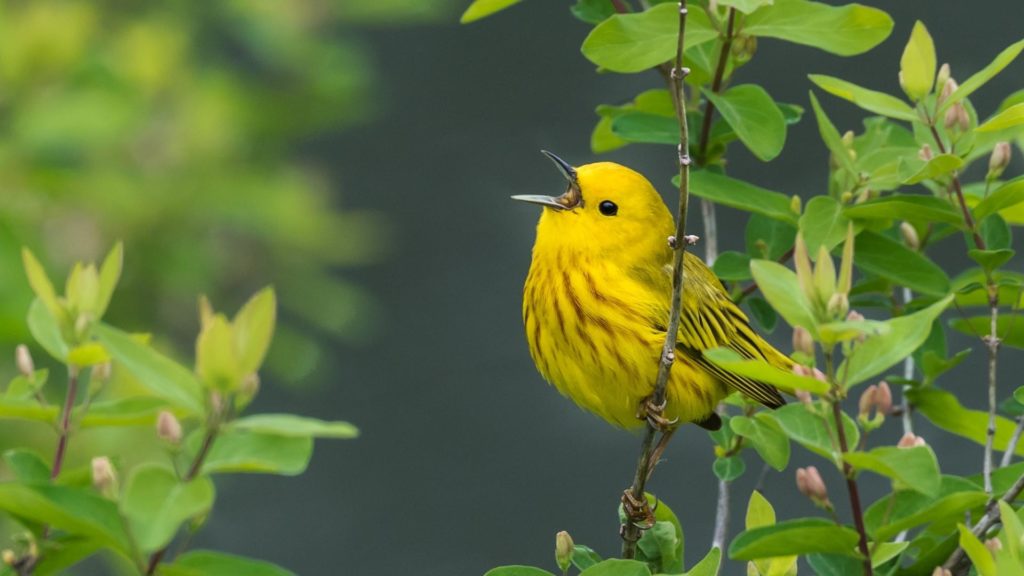
The Yellow Warbler can be spotted in Connecticut between April and October. They grow 4.7 to 5.1 inches and weigh 0.3 to 0.4 ounces with a wingspan between 6.3 and 6.3 and 7.9 inches. The male is yellow with tan stripes down its wings and chest, the female is pure yellow with black eyes.
They live along streams, wetlands, and on the edges of fields feeding on insects, bugs, and even wasps.
Common Birds of Connecticut by Species
Waterfowl/Ducks/Swans in Connecticut
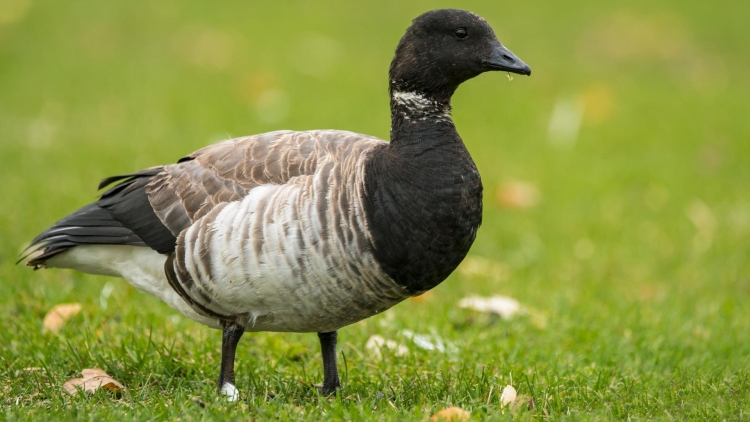
Brant Goose – Branta bernicla – can be spotted in Connecticut, especially at Calf Pasture Beach in Norwalk. The Brant has a small black head with a white line and a small one with a stubby bill. Its body is a rich brown with white beneath its tail. It grows 22 to 26 inches in length and weighs 1.9 to 4.9 pounds with a wingspan of 42 to 48 inches. They live by the water’s edge and feed on aquatic plants, algae, and wigeon grass, but they will occasionally snap up a mollusk or worm.
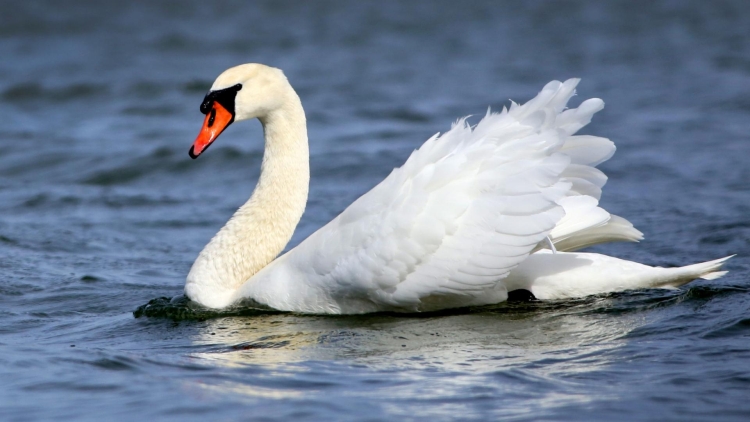
Mute Swan – Cygnus olor – is a large, exotic swan whose population in Connecticut has been growing. Today, there are up to 1,400 Mute Swans breeding in the state’s coastal areas. They have a heavy body with a slender neck and short legs, and their entire body is snowy white with an orange bill. The Mute Swan grows to 50.0 to 59.8 inches in length and weighs 194l.0 to 504.4 ounces with a wingspan between 81.9 to 93.7 inches. They spent a lot of time in the water by city parks and lakes and feed on vegetation found underwater.
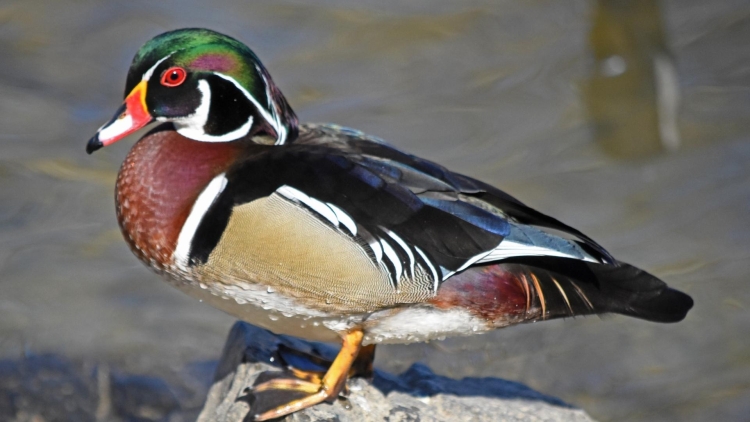
Wood Duck – Aix sponsa – live in Connecticut year-round but are mostly seen during the summer. They are marvelously colorful. The male has a green head with red eyes and a bright pink, white, and blue bill. The body is a multitude of rainbow colors, from a rusty chest, buff sides, to brown backs and tails with white and blue marking. The female has a brownish head and lacks the red eyes. The Wood Duck grows to 18.5 inches in length and weighs 16.0 to 30.4 ounces with a wingspan between 26. 0 to 28.7 inches. They inhabit swampy areas, where they feed on seeds, insects, and fruits while in the water.
Hawks in Connecticut
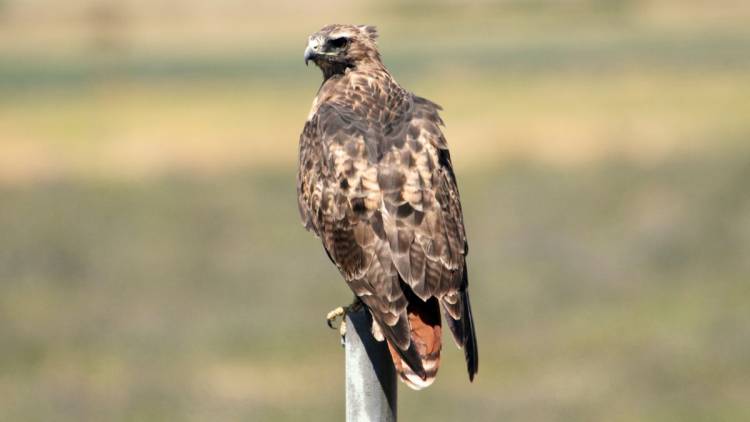
Red-tailed Hawk – Buteo jamaciensis – is a common Connecticut resident. They grow to a length of 17 to 22 inches and weigh from 1.5m to 3 pounds with a wingspan of 3.5 to 4 feet. They have a brown head and back and a white underbelly with a rusty-red tail. Their plumage can vary, but the consistent rusty-red tail is the best means of identifying them. They live in woodlands high up on trees and hunt in fields and meadows for rabbits, chickens, snakes, frogs, etc.
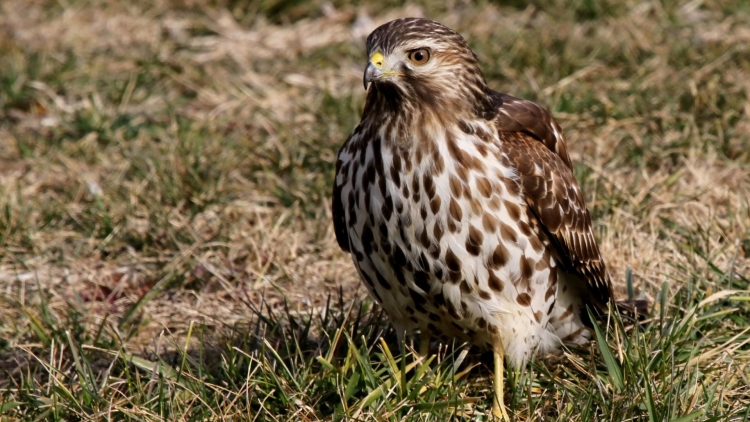
Sharp-shinned Hawks – Accipiter striatus – are large hawks that grow to 10 to 14 inches in length, and weigh between 3 to 4 ounces with a wingspan between 20 to 27 inches. They have a long body, rounded wings, and a long, thin, square tail with a blue-gray back and rusty-colored barred breast. Both males and females look alike, although, the female is the larger of the two.
They prefer nesting in coniferous forests far above the ground. They will hunt small birds along the edge of a forest and even at bird feeders.

Northern Goshawk – Accipiter gentilis – are large with rounded wings and a long tail. They grow 20.9 to 25.2 inches in length and weigh 22.3 to 48.1 ounces with a wingspan between 40.5 to 46.1 inches. Their main habitation is a coniferous forest, but they can be found in deciduous forests, as well. They are various shades of striped gray with noticeable white eyebrows and a long tail that is rounded at the tip. They pounce on their prey silently but fiercely with strong talons. Their prey consists of other birds, and mammals such as squirrels, chipmunks, and rabbits.
Owls in Connecticut
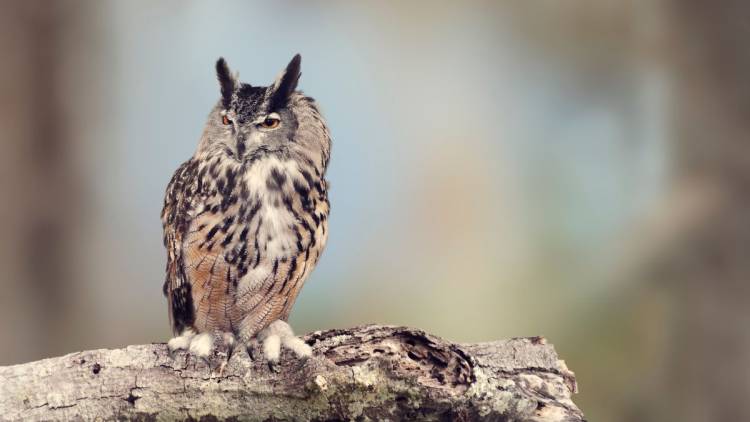
Great Horned Owl – Bubo virginianus – can be spotted all year round in Connecticut. They grow between 18.1 to 24.8 inches in length and weigh 32.1 to 88.2 ounces with a wingspan between 39.8 to 57.1 inches. They have a mottled gray-brown body with a white throat patch that somewhat resembles an unkempt mustache, and tufted ears and yellow eyes. They inhabit forests, swamps, and orchards. Great Horned Owls are fierce predators who will take out raptors and other owls. Otherwise, their diet is varied as they will eat almost anything.

Barred Owl – Strix varia – can be found in the coniferous and deciduous forests of Connecticut as well as swamps and river edges. They grow 16.9 to 19.7 inches in length, and weigh between 16.6 and 37.0 ounces with a wingspan between 39.0 to 43.3 inches. Their body is a mottled brown and white with brown and white stripes on their belly and stripes on their chest and backs. They have brown eyes and lack ear tufts. They feed on mice, squirrels, small birds, and rabbits.
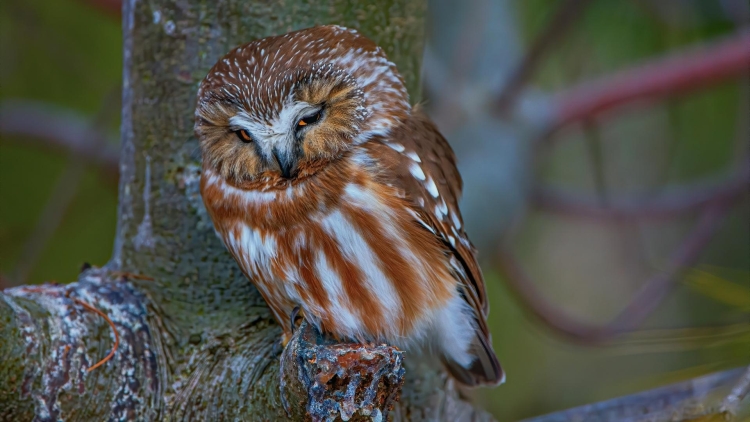
Northern saw-whet Owl – Aegolius acadicus – are tiny owls with a large, round brown-beige head, spotted brown wings and pale striped underside, yellow eyes, and no ear tufts. They grow 7.1 to 8.3 inches in length and weigh 2.3 to 5.3 ounces with a wingspan between 16.5 and 18.9 inches. They live in forests. While they actually look cute and harmless, the mice they fiercely chase do not share that opinion.
Further Reading on Connecticut Birding
For more information on birding in Connecticut, consider the following guidebooks:
Visit these websites for additional information:


